lock BMW 750I SEDAN 2014 Owner's Manual
[x] Cancel search | Manufacturer: BMW, Model Year: 2014, Model line: 750I SEDAN, Model: BMW 750I SEDAN 2014Pages: 265, PDF Size: 5.68 MB
Page 58 of 265
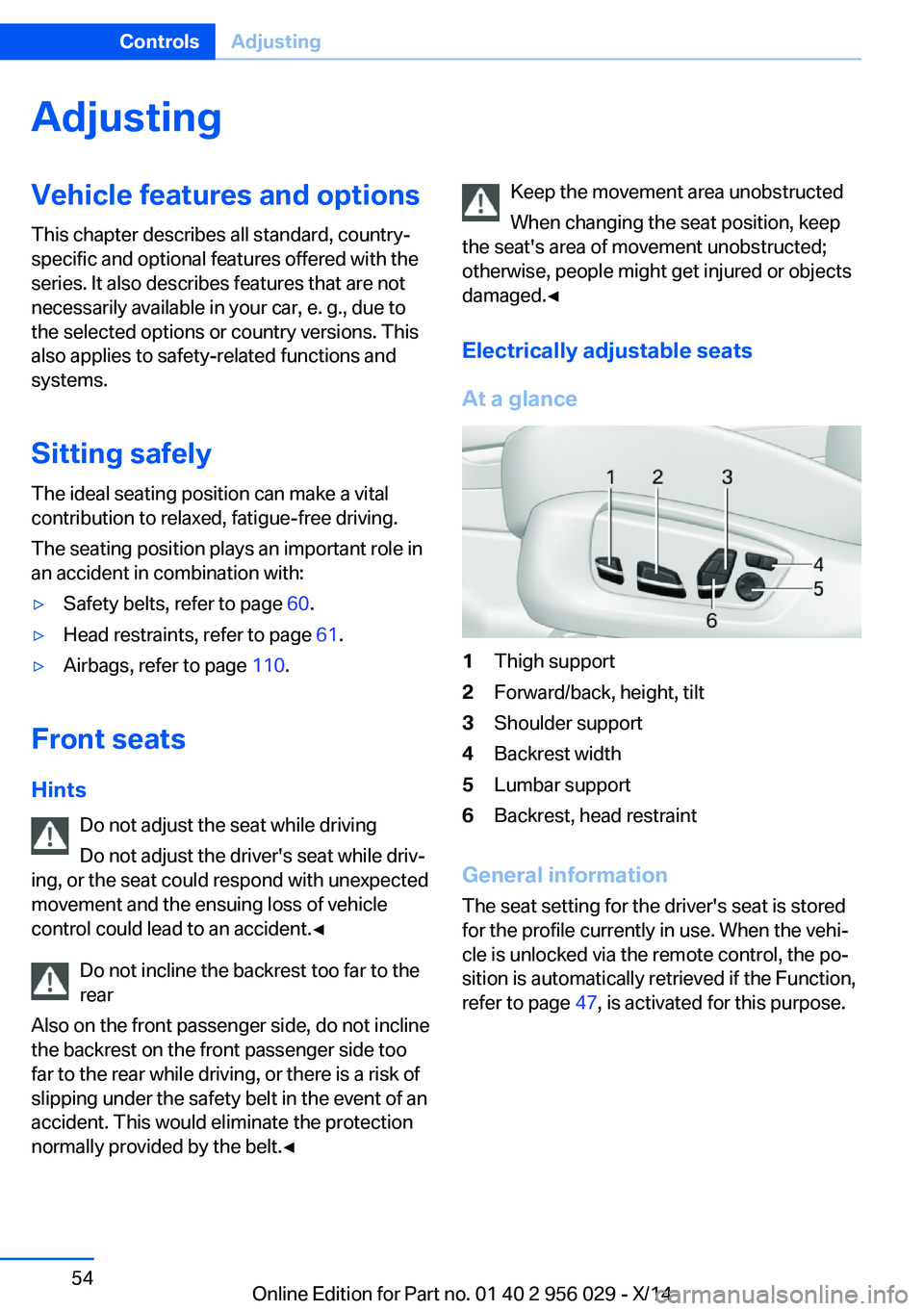
AdjustingVehicle features and options
This chapter describes all standard, country-
specific and optional features offered with the
series. It also describes features that are not
necessarily available in your car, e. g., due to
the selected options or country versions. This
also applies to safety-related functions and
systems.
Sitting safely
The ideal seating position can make a vital
contribution to relaxed, fatigue-free driving.
The seating position plays an important role in
an accident in combination with:тЦ╖Safety belts, refer to page 60.тЦ╖Head restraints, refer to page 61.тЦ╖Airbags, refer to page 110.
Front seats
Hints Do not adjust the seat while driving
Do not adjust the driver's seat while drivтАР
ing, or the seat could respond with unexpected
movement and the ensuing loss of vehicle
control could lead to an accident.тЧА
Do not incline the backrest too far to the
rear
Also on the front passenger side, do not incline
the backrest on the front passenger side too
far to the rear while driving, or there is a risk of
slipping under the safety belt in the event of an
accident. This would eliminate the protection
normally provided by the belt.тЧА
Keep the movement area unobstructed
When changing the seat position, keep
the seat's area of movement unobstructed;
otherwise, people might get injured or objects
damaged.тЧА
Electrically adjustable seats
At a glance1Thigh support2Forward/back, height, tilt3Shoulder support4Backrest width5Lumbar support6Backrest, head restraint
General information
The seat setting for the driver's seat is stored
for the profile currently in use. When the vehiтАР
cle is unlocked via the remote control, the poтАР
sition is automatically retrieved if the Function,
refer to page 47, is activated for this purpose.
Seite 54ControlsAdjusting54
Online Edition for Part no. 01 40 2 956 029 - X/14
Page 64 of 265
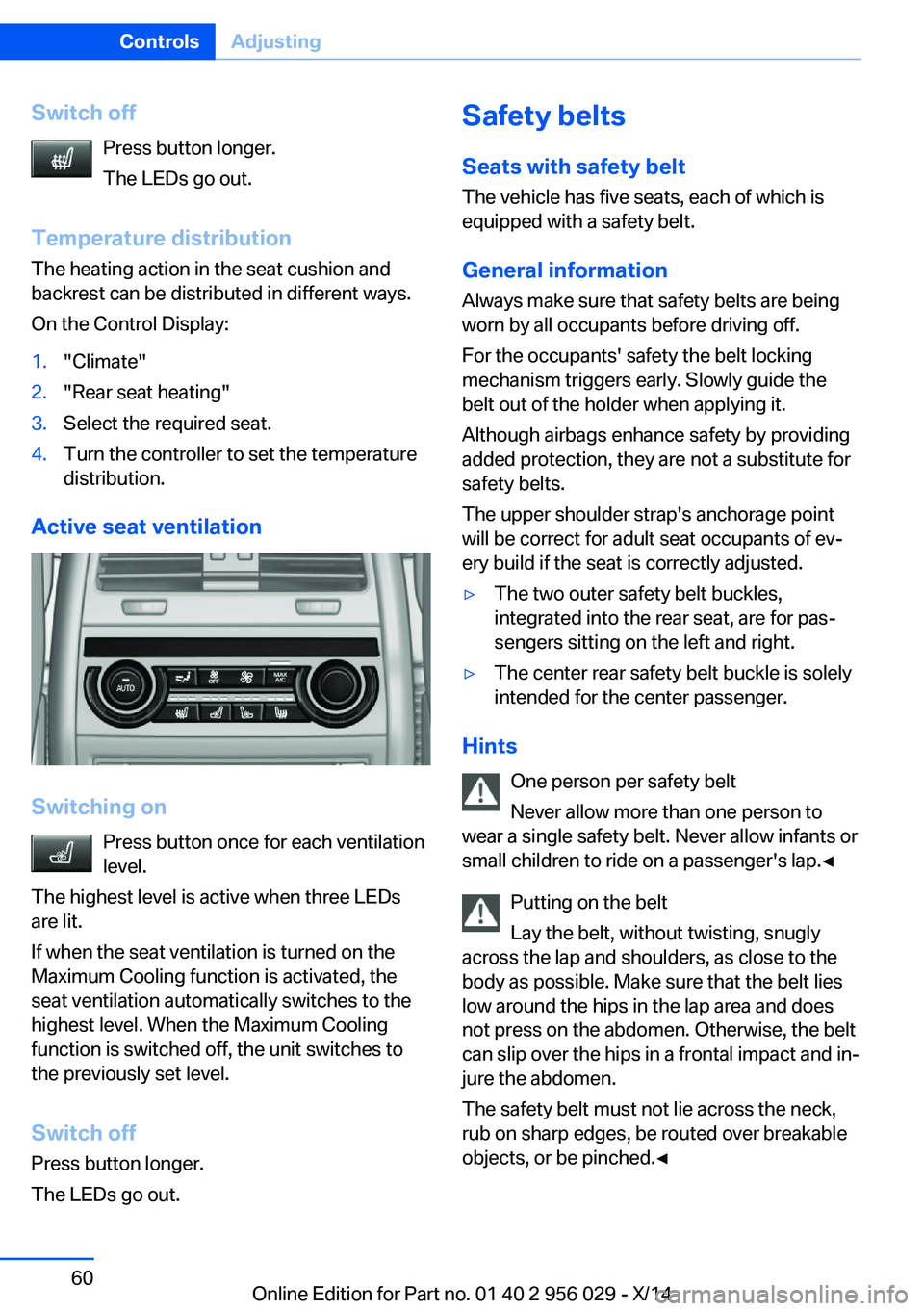
Switch offPress button longer.
The LEDs go out.
Temperature distribution
The heating action in the seat cushion and
backrest can be distributed in different ways.
On the Control Display:1."Climate"2."Rear seat heating"3.Select the required seat.4.Turn the controller to set the temperature
distribution.
Active seat ventilation
Switching on
Press button once for each ventilation
level.
The highest level is active when three LEDs
are lit.
If when the seat ventilation is turned on the
Maximum Cooling function is activated, the
seat ventilation automatically switches to the
highest level. When the Maximum Cooling
function is switched off, the unit switches to
the previously set level.
Switch off Press button longer.
The LEDs go out.
Safety belts
Seats with safety belt
The vehicle has five seats, each of which is
equipped with a safety belt.
General information
Always make sure that safety belts are being
worn by all occupants before driving off.
For the occupants' safety the belt locking
mechanism triggers early. Slowly guide the
belt out of the holder when applying it.
Although airbags enhance safety by providing
added protection, they are not a substitute for
safety belts.
The upper shoulder strap's anchorage point
will be correct for adult seat occupants of evтАР
ery build if the seat is correctly adjusted.тЦ╖The two outer safety belt buckles,
integrated into the rear seat, are for pasтАР
sengers sitting on the left and right.тЦ╖The center rear safety belt buckle is solely
intended for the center passenger.
Hints
One person per safety belt
Never allow more than one person to
wear a single safety belt. Never allow infants or
small children to ride on a passenger's lap.тЧА
Putting on the belt
Lay the belt, without twisting, snugly
across the lap and shoulders, as close to the
body as possible. Make sure that the belt lies
low around the hips in the lap area and does
not press on the abdomen. Otherwise, the belt
can slip over the hips in a frontal impact and inтАР
jure the abdomen.
The safety belt must not lie across the neck,
rub on sharp edges, be routed over breakable
objects, or be pinched.тЧА
Seite 60ControlsAdjusting60
Online Edition for Part no. 01 40 2 956 029 - X/14
Page 69 of 265
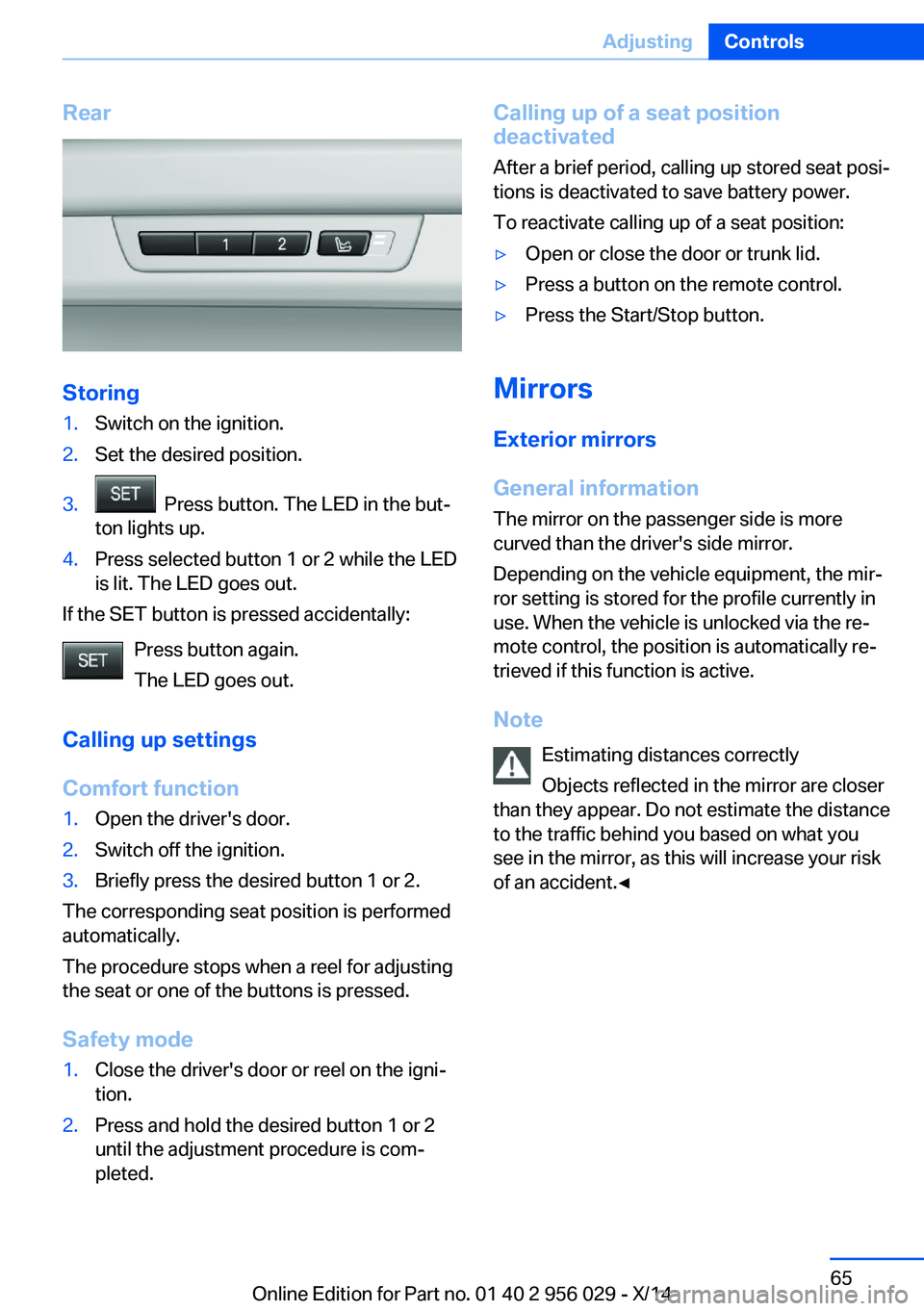
Rear
Storing
1.Switch on the ignition.2.Set the desired position.3. Press button. The LED in the butтАР
ton lights up.4.Press selected button 1 or 2 while the LED
is lit. The LED goes out.
If the SET button is pressed accidentally:
Press button again.
The LED goes out.
Calling up settings
Comfort function
1.Open the driver's door.2.Switch off the ignition.3.Briefly press the desired button 1 or 2.
The corresponding seat position is performed
automatically.
The procedure stops when a reel for adjusting
the seat or one of the buttons is pressed.
Safety mode
1.Close the driver's door or reel on the igniтАР
tion.2.Press and hold the desired button 1 or 2
until the adjustment procedure is comтАР
pleted.Calling up of a seat position
deactivated
After a brief period, calling up stored seat posiтАР
tions is deactivated to save battery power.
To reactivate calling up of a seat position:тЦ╖Open or close the door or trunk lid.тЦ╖Press a button on the remote control.тЦ╖Press the Start/Stop button.
Mirrors
Exterior mirrors
General information The mirror on the passenger side is more
curved than the driver's side mirror.
Depending on the vehicle equipment, the mirтАР
ror setting is stored for the profile currently in
use. When the vehicle is unlocked via the reтАР
mote control, the position is automatically reтАР
trieved if this function is active.
Note Estimating distances correctly
Objects reflected in the mirror are closer
than they appear. Do not estimate the distance
to the traffic behind you based on what you
see in the mirror, as this will increase your risk
of an accident.тЧА
Seite 65AdjustingControls65
Online Edition for Part no. 01 40 2 956 029 - X/14
Page 73 of 265
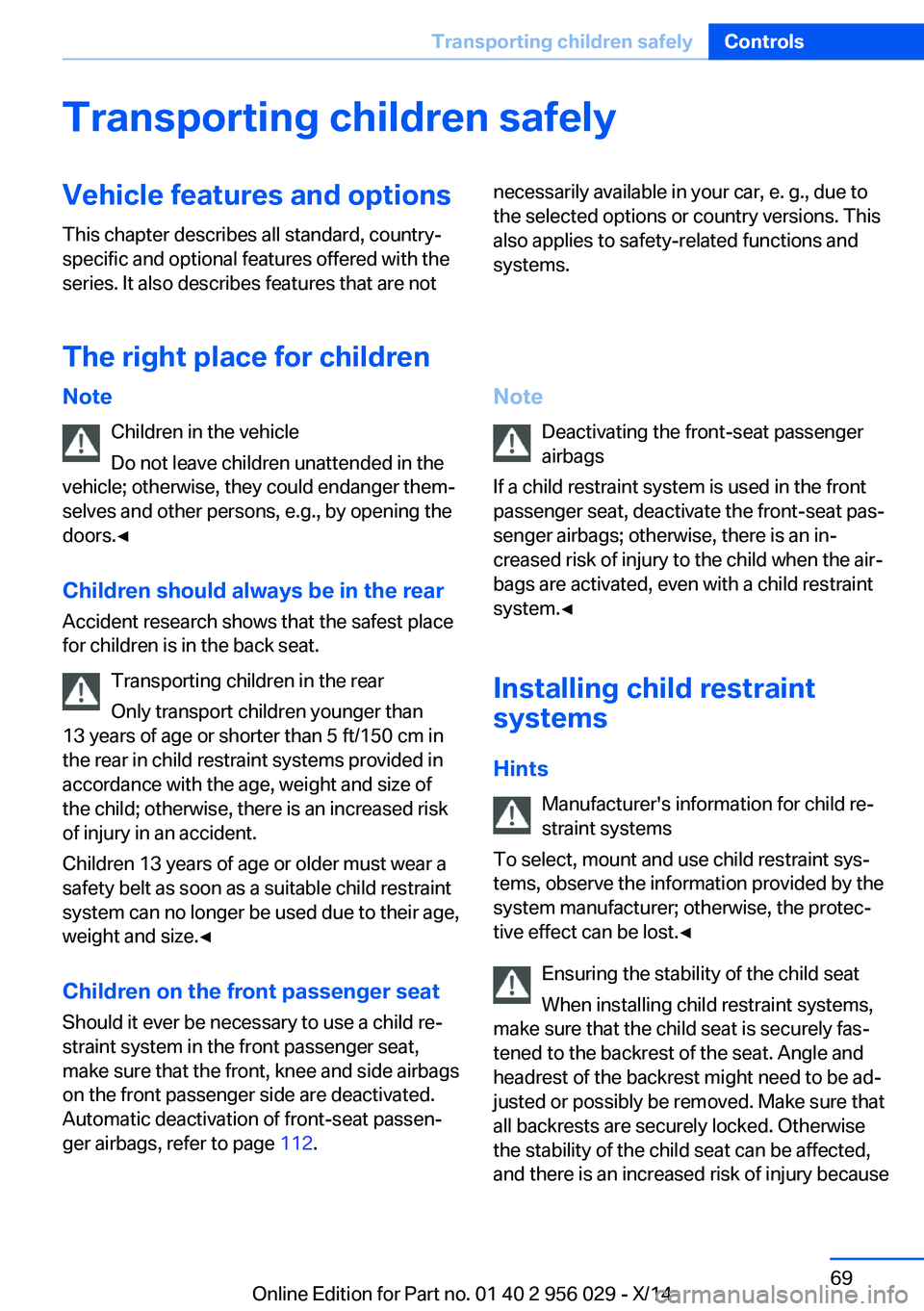
Transporting children safelyVehicle features and optionsThis chapter describes all standard, country-
specific and optional features offered with the
series. It also describes features that are notnecessarily available in your car, e. g., due to
the selected options or country versions. This
also applies to safety-related functions and
systems.
The right place for children
Note
Children in the vehicle
Do not leave children unattended in the
vehicle; otherwise, they could endanger themтАР
selves and other persons, e.g., by opening the
doors.тЧА
Children should always be in the rear Accident research shows that the safest place
for children is in the back seat.
Transporting children in the rear
Only transport children younger than
13 years of age or shorter than 5 ft/150 cm in
the rear in child restraint systems provided in
accordance with the age, weight and size of
the child; otherwise, there is an increased risk
of injury in an accident.
Children 13 years of age or older must wear a
safety belt as soon as a suitable child restraint
system can no longer be used due to their age,
weight and size.тЧА
Children on the front passenger seat
Should it ever be necessary to use a child reтАР
straint system in the front passenger seat,
make sure that the front, knee and side airbags
on the front passenger side are deactivated.
Automatic deactivation of front-seat passenтАР
ger airbags, refer to page 112.Note
Deactivating the front-seat passenger
airbags
If a child restraint system is used in the front
passenger seat, deactivate the front-seat pasтАР
senger airbags; otherwise, there is an inтАР
creased risk of injury to the child when the airтАР
bags are activated, even with a child restraint
system.тЧА
Installing child restraint
systems
Hints Manufacturer's information for child reтАРstraint systems
To select, mount and use child restraint sysтАР
tems, observe the information provided by the
system manufacturer; otherwise, the protecтАР
tive effect can be lost.тЧА
Ensuring the stability of the child seat
When installing child restraint systems,
make sure that the child seat is securely fasтАР
tened to the backrest of the seat. Angle and
headrest of the backrest might need to be adтАР
justed or possibly be removed. Make sure that
all backrests are securely locked. Otherwise
the stability of the child seat can be affected,
and there is an increased risk of injury becauseSeite 69Transporting children safelyControls69
Online Edition for Part no. 01 40 2 956 029 - X/14
Page 74 of 265
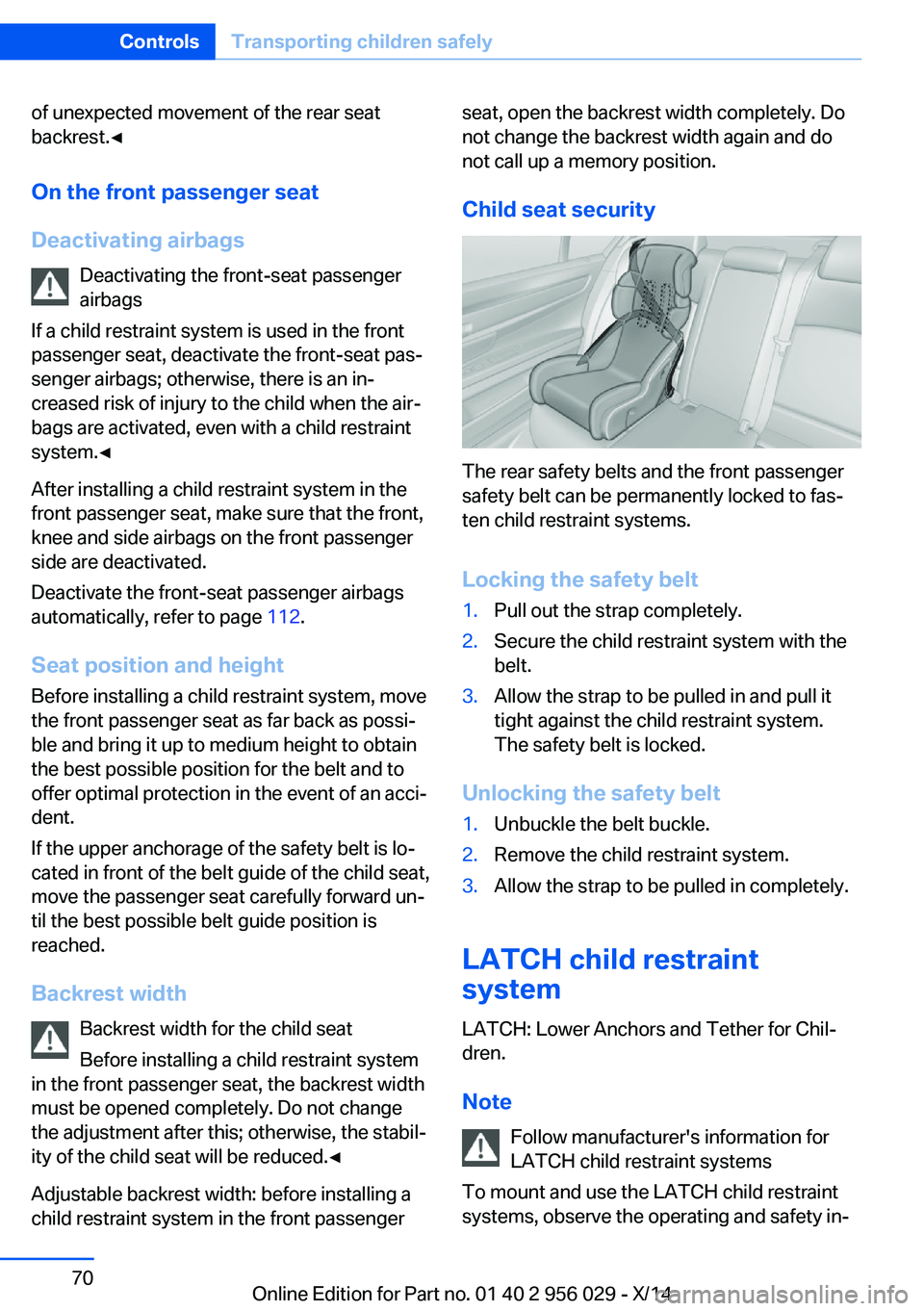
of unexpected movement of the rear seat
backrest.тЧА
On the front passenger seat
Deactivating airbags Deactivating the front-seat passenger
airbags
If a child restraint system is used in the front
passenger seat, deactivate the front-seat pasтАР
senger airbags; otherwise, there is an inтАР
creased risk of injury to the child when the airтАР
bags are activated, even with a child restraint
system.тЧА
After installing a child restraint system in the
front passenger seat, make sure that the front,
knee and side airbags on the front passenger
side are deactivated.
Deactivate the front-seat passenger airbags
automatically, refer to page 112.
Seat position and height
Before installing a child restraint system, move
the front passenger seat as far back as possiтАР
ble and bring it up to medium height to obtain
the best possible position for the belt and to
offer optimal protection in the event of an acciтАР
dent.
If the upper anchorage of the safety belt is loтАР
cated in front of the belt guide of the child seat,
move the passenger seat carefully forward unтАР
til the best possible belt guide position is
reached.
Backrest width Backrest width for the child seat
Before installing a child restraint system
in the front passenger seat, the backrest width
must be opened completely. Do not change
the adjustment after this; otherwise, the stabilтАР
ity of the child seat will be reduced.тЧА
Adjustable backrest width: before installing a
child restraint system in the front passengerseat, open the backrest width completely. Do
not change the backrest width again and do
not call up a memory position.
Child seat security
The rear safety belts and the front passenger
safety belt can be permanently locked to fasтАР
ten child restraint systems.
Locking the safety belt
1.Pull out the strap completely.2.Secure the child restraint system with the
belt.3.Allow the strap to be pulled in and pull it
tight against the child restraint system.
The safety belt is locked.
Unlocking the safety belt
1.Unbuckle the belt buckle.2.Remove the child restraint system.3.Allow the strap to be pulled in completely.
LATCH child restraint
system
LATCH: Lower Anchors and Tether for ChilтАР
dren.
Note Follow manufacturer's information for
LATCH child restraint systems
To mount and use the LATCH child restraint
systems, observe the operating and safety inтАР
Seite 70ControlsTransporting children safely70
Online Edition for Part no. 01 40 2 956 029 - X/14
Page 76 of 265
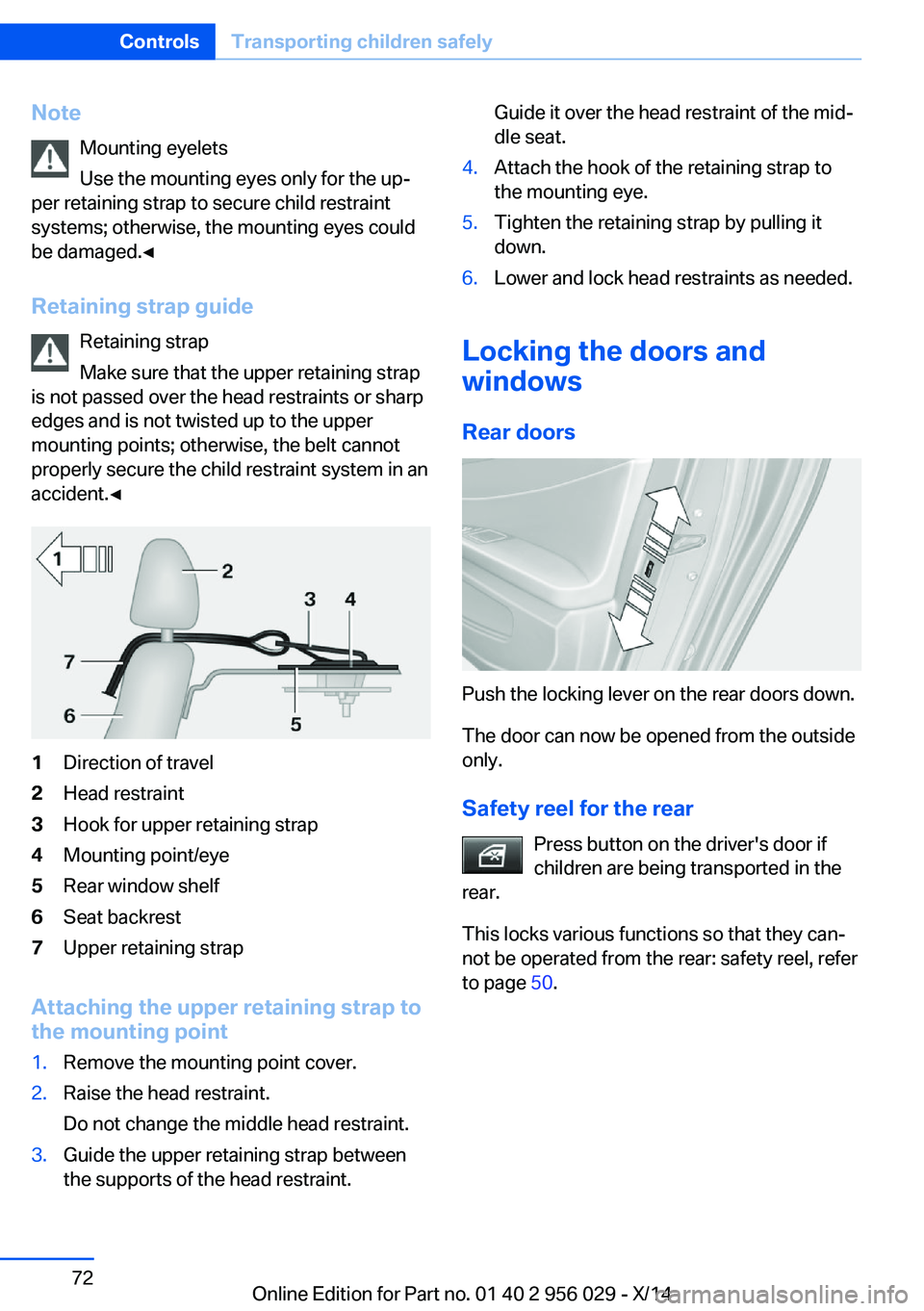
NoteMounting eyelets
Use the mounting eyes only for the upтАР
per retaining strap to secure child restraint
systems; otherwise, the mounting eyes could
be damaged.тЧА
Retaining strap guide Retaining strap
Make sure that the upper retaining strap
is not passed over the head restraints or sharp
edges and is not twisted up to the upper
mounting points; otherwise, the belt cannot
properly secure the child restraint system in an
accident.тЧА1Direction of travel2Head restraint3Hook for upper retaining strap4Mounting point/eye5Rear window shelf6Seat backrest7Upper retaining strap
Attaching the upper retaining strap to
the mounting point
1.Remove the mounting point cover.2.Raise the head restraint.
Do not change the middle head restraint.3.Guide the upper retaining strap between
the supports of the head restraint.Guide it over the head restraint of the midтАР
dle seat.4.Attach the hook of the retaining strap to
the mounting eye.5.Tighten the retaining strap by pulling it
down.6.Lower and lock head restraints as needed.
Locking the doors and
windows
Rear doors
Push the locking lever on the rear doors down.
The door can now be opened from the outside
only.
Safety reel for the rear Press button on the driver's door if
children are being transported in the
rear.
This locks various functions so that they canтАР
not be operated from the rear: safety reel, refer
to page 50.
Seite 72ControlsTransporting children safely72
Online Edition for Part no. 01 40 2 956 029 - X/14
Page 77 of 265
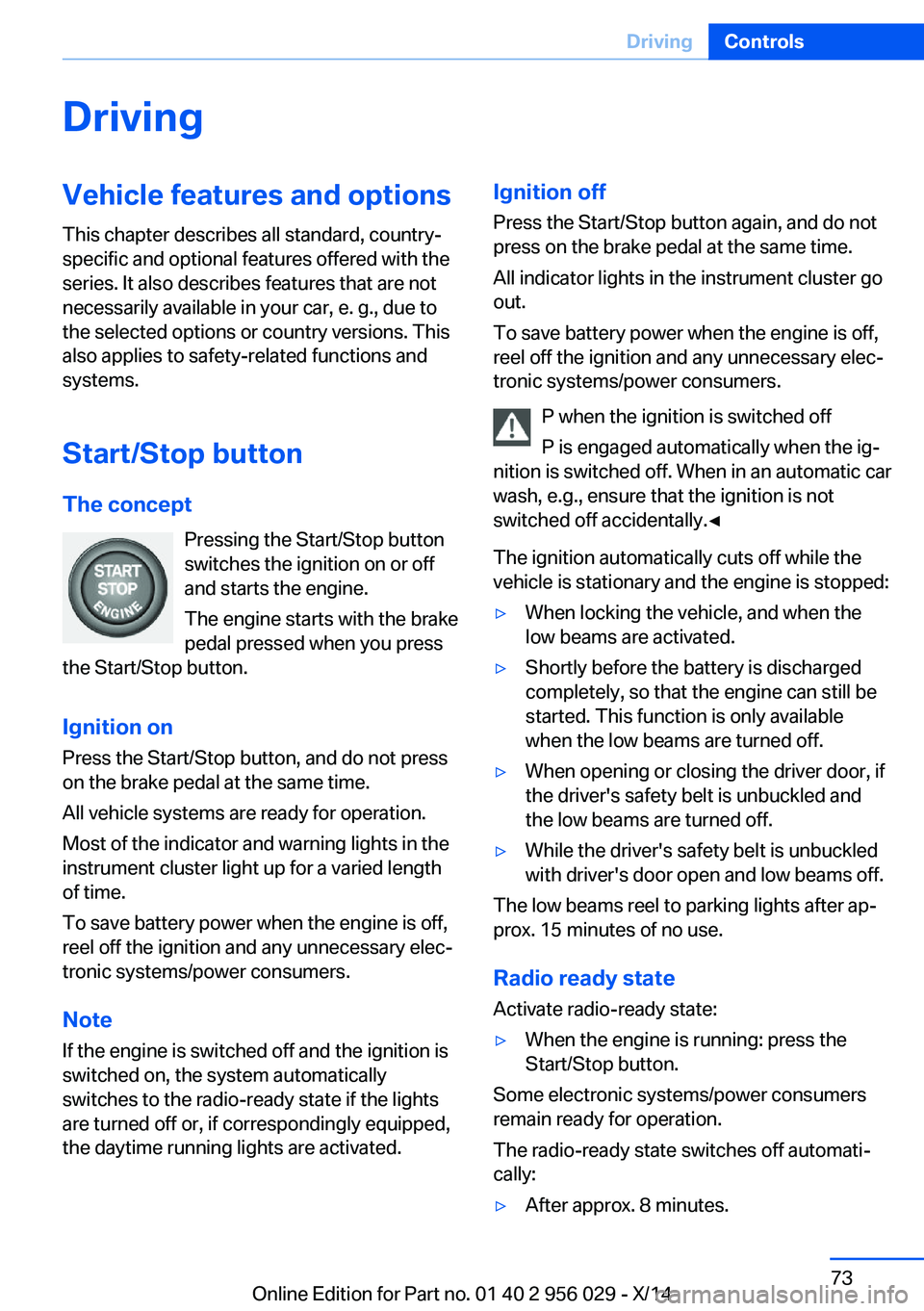
DrivingVehicle features and options
This chapter describes all standard, country-
specific and optional features offered with the
series. It also describes features that are not
necessarily available in your car, e. g., due to
the selected options or country versions. This
also applies to safety-related functions and
systems.
Start/Stop button
The concept Pressing the Start/Stop button
switches the ignition on or off
and starts the engine.
The engine starts with the brake
pedal pressed when you press
the Start/Stop button.
Ignition onPress the Start/Stop button, and do not press
on the brake pedal at the same time.
All vehicle systems are ready for operation.
Most of the indicator and warning lights in the
instrument cluster light up for a varied length
of time.
To save battery power when the engine is off,
reel off the ignition and any unnecessary elecтАР
tronic systems/power consumers.
Note If the engine is switched off and the ignition is
switched on, the system automatically
switches to the radio-ready state if the lights
are turned off or, if correspondingly equipped,
the daytime running lights are activated.Ignition off
Press the Start/Stop button again, and do not
press on the brake pedal at the same time.
All indicator lights in the instrument cluster go
out.
To save battery power when the engine is off,
reel off the ignition and any unnecessary elecтАР
tronic systems/power consumers.
P when the ignition is switched off
P is engaged automatically when the igтАР
nition is switched off. When in an automatic car wash, e.g., ensure that the ignition is not
switched off accidentally.тЧА
The ignition automatically cuts off while the
vehicle is stationary and the engine is stopped:тЦ╖When locking the vehicle, and when the
low beams are activated.тЦ╖Shortly before the battery is discharged
completely, so that the engine can still be
started. This function is only available
when the low beams are turned off.тЦ╖When opening or closing the driver door, if
the driver's safety belt is unbuckled and
the low beams are turned off.тЦ╖While the driver's safety belt is unbuckled
with driver's door open and low beams off.
The low beams reel to parking lights after apтАР
prox. 15 minutes of no use.
Radio ready state
Activate radio-ready state:
тЦ╖When the engine is running: press the
Start/Stop button.
Some electronic systems/power consumers
remain ready for operation.
The radio-ready state switches off automatiтАР
cally:
тЦ╖After approx. 8 minutes.Seite 73DrivingControls73
Online Edition for Part no. 01 40 2 956 029 - X/14
Page 78 of 265
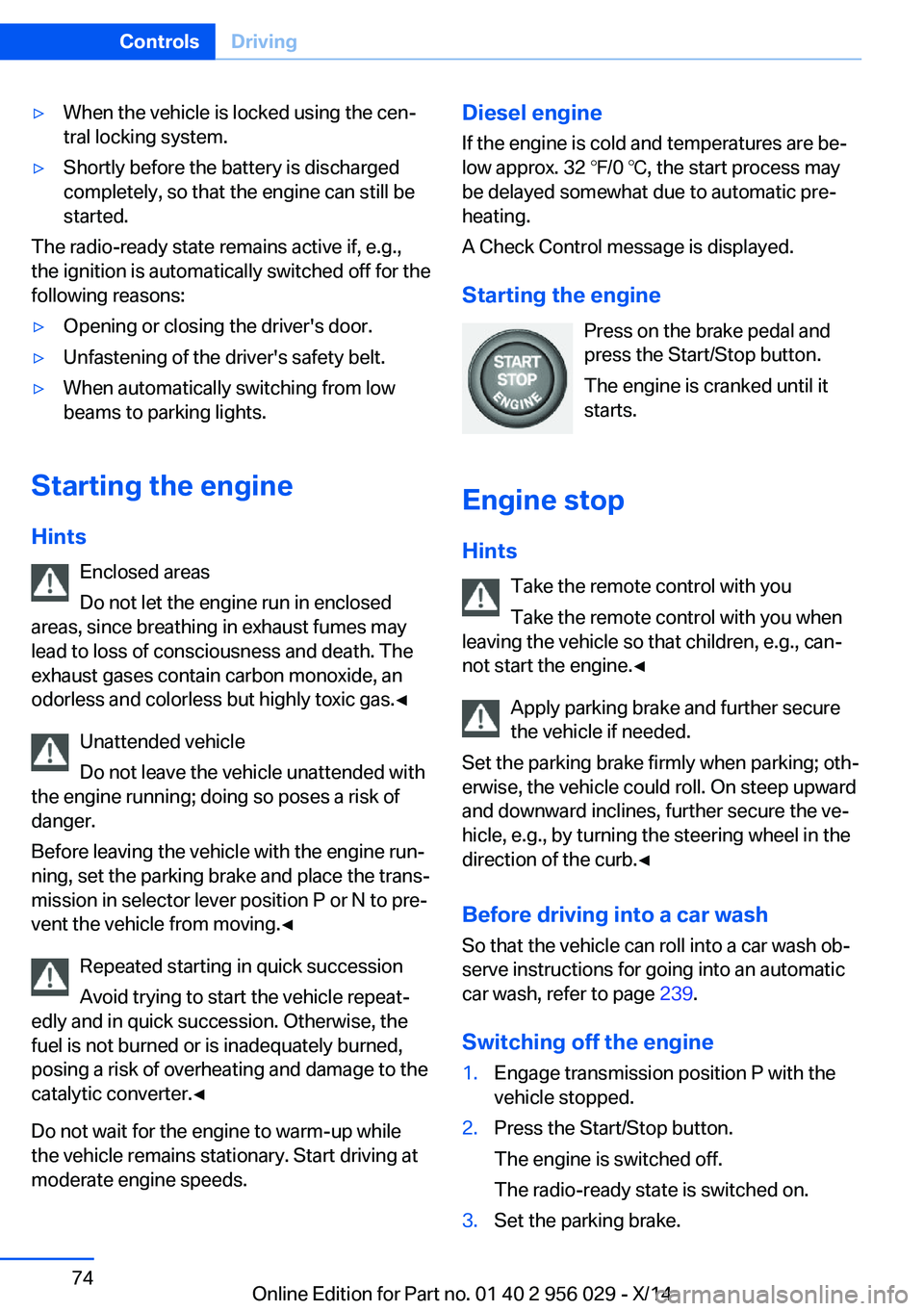
тЦ╖When the vehicle is locked using the cenтАР
tral locking system.тЦ╖Shortly before the battery is discharged
completely, so that the engine can still be
started.
The radio-ready state remains active if, e.g.,
the ignition is automatically switched off for the
following reasons:
тЦ╖Opening or closing the driver's door.тЦ╖Unfastening of the driver's safety belt.тЦ╖When automatically switching from low
beams to parking lights.
Starting the engine
Hints Enclosed areas
Do not let the engine run in enclosed
areas, since breathing in exhaust fumes may
lead to loss of consciousness and death. The
exhaust gases contain carbon monoxide, an
odorless and colorless but highly toxic gas.тЧА
Unattended vehicle
Do not leave the vehicle unattended with
the engine running; doing so poses a risk of
danger.
Before leaving the vehicle with the engine runтАР
ning, set the parking brake and place the transтАР
mission in selector lever position P or N to preтАР
vent the vehicle from moving.тЧА
Repeated starting in quick succession
Avoid trying to start the vehicle repeatтАР
edly and in quick succession. Otherwise, the fuel is not burned or is inadequately burned,
posing a risk of overheating and damage to the
catalytic converter.тЧА
Do not wait for the engine to warm-up while
the vehicle remains stationary. Start driving at
moderate engine speeds.
Diesel engine
If the engine is cold and temperatures are beтАР
low approx. 32 тДЙ/0 тДГ, the start process may
be delayed somewhat due to automatic preтАР
heating.
A Check Control message is displayed.
Starting the engine Press on the brake pedal and
press the Start/Stop button.
The engine is cranked until it
starts.
Engine stop Hints Take the remote control with youTake the remote control with you when
leaving the vehicle so that children, e.g., canтАР
not start the engine.тЧА
Apply parking brake and further secure
the vehicle if needed.
Set the parking brake firmly when parking; othтАР
erwise, the vehicle could roll. On steep upward
and downward inclines, further secure the veтАР
hicle, e.g., by turning the steering wheel in the
direction of the curb.тЧА
Before driving into a car wash
So that the vehicle can roll into a car wash obтАР
serve instructions for going into an automatic
car wash, refer to page 239.
Switching off the engine1.Engage transmission position P with the
vehicle stopped.2.Press the Start/Stop button.
The engine is switched off.
The radio-ready state is switched on.3.Set the parking brake.Seite 74ControlsDriving74
Online Edition for Part no. 01 40 2 956 029 - X/14
Page 79 of 265
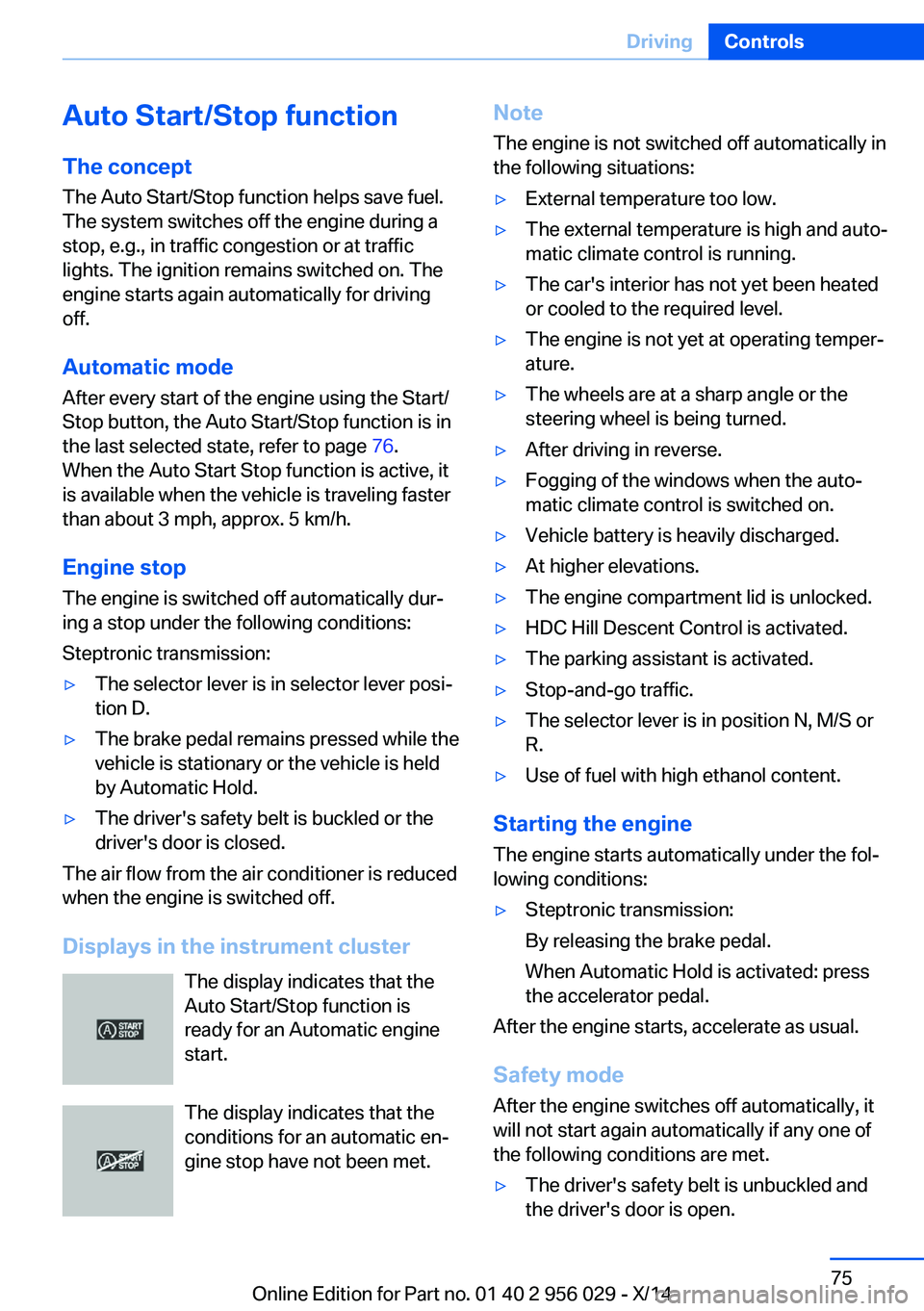
Auto Start/Stop function
The concept The Auto Start/Stop function helps save fuel.
The system switches off the engine during a
stop, e.g., in traffic congestion or at traffic lights. The ignition remains switched on. The
engine starts again automatically for driving
off.
Automatic mode After every start of the engine using the Start/
Stop button, the Auto Start/Stop function is in
the last selected state, refer to page 76.
When the Auto Start Stop function is active, it
is available when the vehicle is traveling faster
than about 3 mph, approx. 5 km/h.
Engine stop
The engine is switched off automatically durтАР
ing a stop under the following conditions:
Steptronic transmission:тЦ╖The selector lever is in selector lever posiтАР
tion D.тЦ╖The brake pedal remains pressed while the
vehicle is stationary or the vehicle is held
by Automatic Hold.тЦ╖The driver's safety belt is buckled or the
driver's door is closed.
The air flow from the air conditioner is reduced
when the engine is switched off.
Displays in the instrument cluster The display indicates that the
Auto Start/Stop function is
ready for an Automatic engine
start.
The display indicates that the conditions for an automatic enтАР
gine stop have not been met.
Note
The engine is not switched off automatically in
the following situations:тЦ╖External temperature too low.тЦ╖The external temperature is high and autoтАР
matic climate control is running.тЦ╖The car's interior has not yet been heated
or cooled to the required level.тЦ╖The engine is not yet at operating temperтАР
ature.тЦ╖The wheels are at a sharp angle or the
steering wheel is being turned.тЦ╖After driving in reverse.тЦ╖Fogging of the windows when the autoтАР
matic climate control is switched on.тЦ╖Vehicle battery is heavily discharged.тЦ╖At higher elevations.тЦ╖The engine compartment lid is unlocked.тЦ╖HDC Hill Descent Control is activated.тЦ╖The parking assistant is activated.тЦ╖Stop-and-go traffic.тЦ╖The selector lever is in position N, M/S or
R.тЦ╖Use of fuel with high ethanol content.
Starting the engine
The engine starts automatically under the folтАР
lowing conditions:
тЦ╖Steptronic transmission:
By releasing the brake pedal.
When Automatic Hold is activated: press
the accelerator pedal.
After the engine starts, accelerate as usual.
Safety mode
After the engine switches off automatically, it
will not start again automatically if any one of
the following conditions are met.
тЦ╖The driver's safety belt is unbuckled and
the driver's door is open.Seite 75DrivingControls75
Online Edition for Part no. 01 40 2 956 029 - X/14
Page 80 of 265
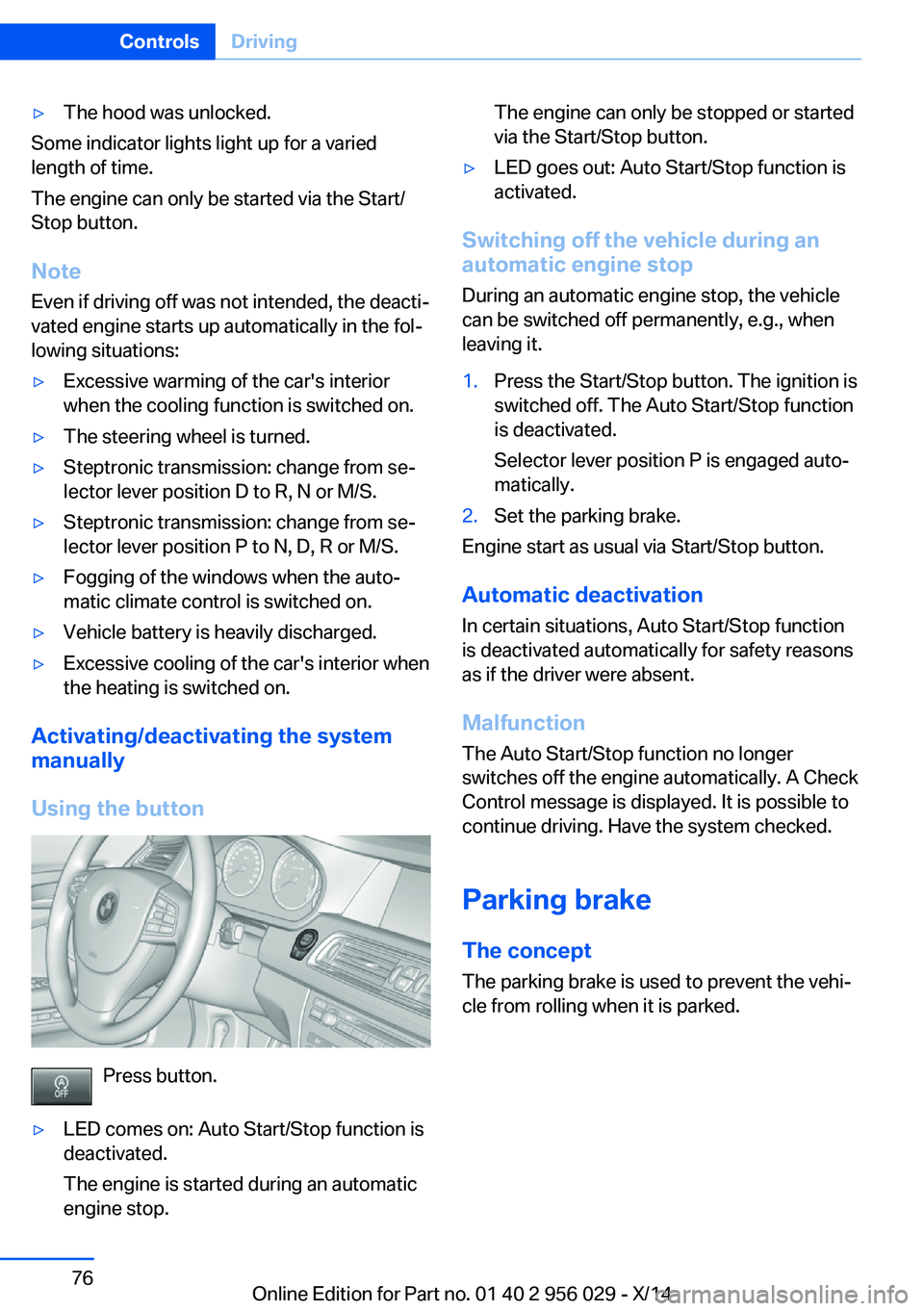
тЦ╖The hood was unlocked.
Some indicator lights light up for a varied
length of time.
The engine can only be started via the Start/
Stop button.
Note Even if driving off was not intended, the deactiтАР
vated engine starts up automatically in the folтАР
lowing situations:
тЦ╖Excessive warming of the car's interior
when the cooling function is switched on.тЦ╖The steering wheel is turned.тЦ╖Steptronic transmission: change from seтАР
lector lever position D to R, N or M/S.тЦ╖Steptronic transmission: change from seтАР
lector lever position P to N, D, R or M/S.тЦ╖Fogging of the windows when the autoтАР
matic climate control is switched on.тЦ╖Vehicle battery is heavily discharged.тЦ╖Excessive cooling of the car's interior when
the heating is switched on.
Activating/deactivating the system
manually
Using the button
Press button.
тЦ╖LED comes on: Auto Start/Stop function is
deactivated.
The engine is started during an automatic
engine stop.The engine can only be stopped or started
via the Start/Stop button.тЦ╖LED goes out: Auto Start/Stop function is
activated.
Switching off the vehicle during an
automatic engine stop
During an automatic engine stop, the vehicle
can be switched off permanently, e.g., when
leaving it.
1.Press the Start/Stop button. The ignition is
switched off. The Auto Start/Stop function
is deactivated.
Selector lever position P is engaged autoтАР
matically.2.Set the parking brake.
Engine start as usual via Start/Stop button.
Automatic deactivation
In certain situations, Auto Start/Stop function
is deactivated automatically for safety reasons
as if the driver were absent.
Malfunction
The Auto Start/Stop function no longer
switches off the engine automatically. A Check
Control message is displayed. It is possible to
continue driving. Have the system checked.
Parking brake The concept
The parking brake is used to prevent the vehiтАР
cle from rolling when it is parked.
Seite 76ControlsDriving76
Online Edition for Part no. 01 40 2 956 029 - X/14